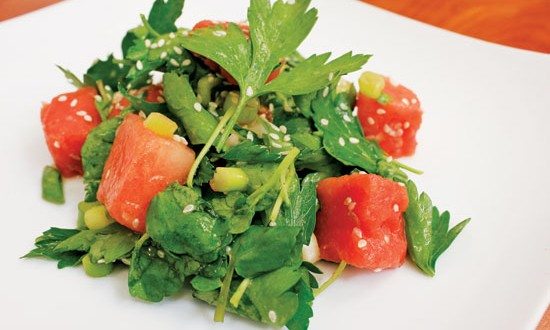
WATERCRESS
Botanical name: Nasturtium officianale
An aquatic plant found near springs and slow-moving streams, watercress is an often-overlooked, leafy green food source that is a close cousin to mustard greens, cabbage, and arugula. An attractive, succulent plant, watercress bears small, round, slightly scalloped leaves, which, in summer, produce tiny white flowers that become small pods with two rows of edible seeds. Watercress has been cultivated in Europe, Central Asia, and the Americas for millennia for use as both food and a medicine.
One of the best culinary aspects of watercress is its versatility. It can be used as a salad green (a very nutritious one!) with Romaine lettuce or fresh spinach, steamed and eaten as a vegetable, and in soups for a subtle, peppery flavor. It's also a standard ingredient for sandwiches in Britain for both common and high tea.
Because watercress grows in water, it should be washed thoroughly, then soaked for half an hour or so in cool water with hydrogen peroxide added (around one tablespoon per quart) to remove any pollutants, parasites, or other impurities. For optimum freshness, watercress can be submerged in water and stored in the refrigerator for two to three days. Before eating, rinse again and separate the leaves from the fibers and roots.
Health Benefits of Watercress
Watercress earned its reputation as a healing herb quite early. Around 400 BC, Hippocrates located the first hospital on the island of Kos close to a stream to ensure that fresh watercress would be available for treating patients. In the 1700s, Nicholas Culpeper (author of Culpeper's Herbal) believed watercress could cleanse the blood. Modern science has identified more than 15 essential vitamins and minerals contained in this one herb – more iron than spinach, more calcium than milk, and more vitamin C than oranges.
Watercress is very low in calories, but contains phytonutrients like isothiocyanates and antioxidants with a plethora of disease-preventive properties. Gluconasturtiin, a glucosinolate compound providing the peppery flavor, is one of them, contained in the leaves and stems and providing phenethyl isothiocyanates, shown to inhibit carcinogens.
Vitamin K is by far the most prominent nutrient in watercress, with 312% of the daily recommended value. It forms and strengthens the bones and limits neuronal damage in the brain, which is helpful in treating Alzheimer's disease. There's also vitamin C, with 72% of the daily value, closely followed by vitamin A with 64%. Vitamin C provides top-notch infection-fighting power to stave off colds and flu, help maintain healthy connective tissue, and prevent iron deficiency. Vitamin A, also known as retinol, is essential for a properly functioning immune system and produces pigments in the retina of the eye, an absence of which can cause night blindness.
Manganese is a cofactor for the antioxidant enzyme superoxide dismutase, and calcium for strong bones and teeth come in high doses when you eat watercress. Antioxidant flavonoids like ß carotene, zeaxanthin, and lutein protect from lung and mouth cancers. B-complex vitamins include riboflavin, niacin, vitamin B6 (pyridoxine), thiamin, and pantothenic acid, all important for keeping your cellular metabolic functions at peak performance.
http://foodfacts.mercola.com/watercress.html
Recipes
Watermelon and Watercress Salad with Ginger
Ingredients:
• 2 tablespoons rice vinegar
• 1 1/2 tablespoons vegetable oil
• 2 teaspoons minced peeled fresh ginger
• 1 1/2 teaspoons grated lime peel
• 1 garlic clove, minced
• 2 cups 1/2-inch pieces peeled seedless watermelon
• 1 large bunch watercress, thick stems trimmed (about 2 cups packed)
• 1 cup 1/2-inch pieces peeled seeded cucumber (about 1/2 large)
• 4 green onions, thinly sliced diagonally
• 1/4 cup chopped fresh cilantro
Directions:
• Whisk vinegar, oil, ginger, lime peel, and garlic in large bowl to blend. Season to taste with salt and pepper. Add watermelon and all remaining ingredients to bowl with dressing and toss to coat. Divide salad among 4 plates and serve.
http://www.bonappetit.com/recipe/watermelon-and-watercress-salad-with-ginger

